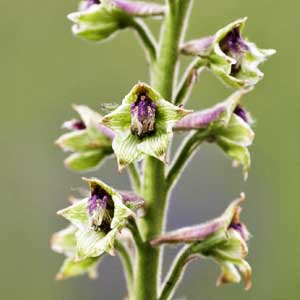Delphinium viridescens
Delphinium
Wenatchee larkspur
delphinium, larkspur
90-150 cm;
base usually green, glabrous.
blade cuneate to semicircular, 2-5 × 3-12 cm, nearly glabrous; ultimate lobes 3-21, width 1-8 mm.
blade deeply palmately divided, round to pentagonal or reniform, margins entire or lobes apically crenate or lacerate, lobes of basal blades wider and fewer than those of cauline blades.
25-80-flowered, dense;
pedicel 0.5-2 cm, glandular-pubescent;
bracteoles 1-4 mm from flowers, green, lanceolate, 3.5-6 mm, glandular-pubescent.
terminal, 2-100(-more)-flowered racemes (occasionally branched, thus technically panicles), 5-40 cm or more;
bracts subtending inflorescence branches;
pedicels present or absent;
bracteoles (on pedicels) subopposite-subalternate, not forming involucre.
sepals yellowish green, nearly glabrous, lateral sepals forward pointing, 7-9 × 3-4 mm, spurs decurved, 30-45° below horizontal, often hooked apically, 8-11 mm;
lower petal blades ± covering stamens, 4-6 mm, clefts 0.5-1.5 mm;
hairs centered, mostly near junction of blade and claw, yellow.
bisexual, bilaterally symmetric;
sepals not persistent in fruit, 5;
upper sepal 1, spurred, 8-24 mm;
lateral sepals 2, ± ovate to elliptic, 8-18 mm;
lower sepals 2, similar to lateral sepals;
upper petals 2, spurred, enclosed in upper sepal, nectary inside tip of spur;
lower petals 2, plane, ± ovate, ± 2-lobed, clawed, 2-12 mm, nectary absent;
stamens 25-40;
filaments with base expanded;
staminodes absent between stamens and pistils;
pistils 3(-5), simple;
ovules 8-20 per pistil;
style present.
8-11 mm, 2.5-3 times longer than wide, puberulent.
follicles, aggregate, sessile, ± curved-cylindric, sides prominently veined or not;
beak terminal, straight, 2-4 mm.
± wing-margined;
seed coat cells with surfaces ± roughened.
dark brown to black (often appearing white because of air in seed coat cells), rectangular to pyramidal, often ± rough surfaced.
= 8.
Delphinium viridescens
Delphinium
Of conservation concern.
Delphinium viridescens is local in mountains southwest of Wenatchee, Washington.
(Discussion copyrighted by Flora of North America; reprinted with permission.)
Species ca. 300 (61 in the flora).
Three Eurasian species of Delphinium–D. elatum Linnaeus, D. grandiflorum Linnaeus, and D. tatsienense Franchet–have been commonly cultivated in North America. Of the nonnative taxa, only D. elatum is sporadically naturalized, as far as is known. Isolating mechanisms in Delphinium appear to be primarily ecological, geographic, and/or temporal. Where these distinctions are disrupted, introgression often exists. Hybridization occurs regularly between certain taxa, particularly in areas of disturbance (e.g., roadcuts, drainage ditches, clearcuts). The more common and easily recognized hybrids are included in the key.
Many names have been misapplied in Delphinium. The few misapplied names mentioned in discussions below refer to relatively widespread problems.
Unless otherwise noted, the key and descriptions refer to fresh material. Some features may be significantly altered by pressing; they can, however, usually be determined with a certain amount of effort and experience.
In the descriptions, "base of cleft" refers to the point where the cleft or sinus reaches most deeply into the petal blade.
(Discussion copyrighted by Flora of North America; reprinted with permission.)
1. Lower petal blades less than 1/5 length of lateral sepals; sepals never red or yellow. | Sect. Elatopsis |
1. Lower petal blades more than 1/5 length of lateral sepals; sepals blue, purple, white, red, or yellow. | Sect. Diedropetala |


